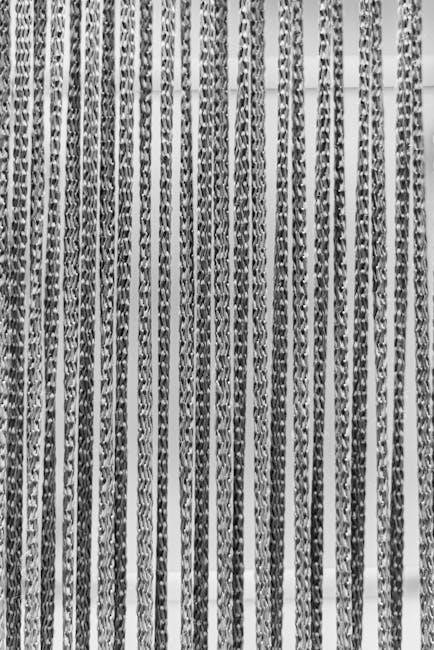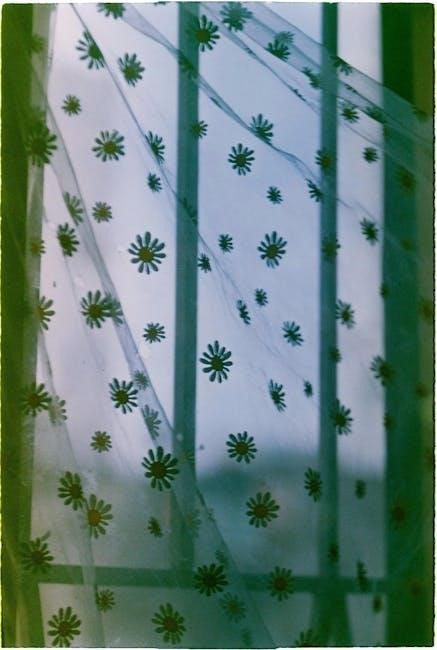Title
The Tortilla Curtain: A Novel by T․C․ Boyle (PDF)
Explore the gripping story of class divides, immigration, and societal tensions in California, available for download in PDF format․
The Tortilla Curtain by T․C․ Boyle is a compelling narrative that explores the complexities of class divides, immigration, and societal tensions in California․ The novel delves into the lives of two families: the privileged Mossbachers and the struggling Mexican immigrants, Candido and América․ Through their intertwined stories, Boyle examines themes of privilege, poverty, and cultural clashes, offering a poignant commentary on modern America․ Available in PDF format, this gripping tale is a must-read for those interested in contemporary social issues․
Author Background
T․C․ Boyle is a renowned American novelist and short-story writer, born in 1948․ Known for his vivid storytelling and exploration of social issues, Boyle has authored numerous works, including The Tortilla Curtain, which highlights his ability to weave compelling narratives around themes of class, immigration, and cultural divides․
3․1․ T․C․ Boyle’s Literary Career
T․C․ Boyle is a celebrated American novelist and short-story writer, known for his dynamic narratives and exploration of contemporary issues․ His literary career spans over four decades, with works like World’s End and Drop City earning critical acclaim․ Boyle’s writing often blends humor, satire, and social commentary, making him a significant voice in modern literature․ His novel The Tortilla Curtain stands out for its poignant portrayal of class and immigration conflicts in California․
3․2․ Boyle’s Style and Themes
T․C․ Boyle’s writing style is marked by satire, dark humor, and intricate narrative structures․ His works often explore themes of moral ambiguity, environmental degradation, and societal conflicts․ In The Tortilla Curtain, Boyle uses vivid descriptions and multiple perspectives to examine issues like class divisions and immigration․ His descriptive technique immerses readers in the California landscape, blending social commentary with compelling storytelling to create a thought-provoking narrative․

Plot Summary
The story intertwines the lives of the affluent Mossbacher family and the struggling Rincon family, exploring clashes over class, immigration, and environmental chaos in suburban California․
4․1․ The Mossbacher Family
The Mossbacher family represents privilege and suburban complacency, living in a gated community in California․ Delaney, an environmentalist, and his wife Kyra navigate their affluent lifestyle, while their son Jordan embodies youthful innocence․ Their seemingly perfect world contrasts with the struggles of the Rincon family, highlighting societal divides and the complexities of privilege, environmentalism, and immigration, central to the novel’s themes․
4․2․ Candido Rincon’s Story
Candido Rincon, an undocumented Mexican immigrant, faces immense struggles in pursuit of a better life․ With his wife América and son, he endures poverty, exploitation, and societal marginalization․ His journey intertwines with the Mossbachers when a car collision sparks tension․ Candido’s resilience and determination highlight the harsh realities of immigration, while his story serves as a counterpoint to the privilege of the Mossbachers, deepening the novel’s exploration of class and identity․

Key Themes
The novel explores themes of class divide, immigration, and environmentalism, highlighting societal tensions and the clash between privilege and poverty through intertwined narratives․
5․1․ Class Divide
The novel vividly portrays the economic disparity between the affluent Mossbachers and the impoverished Rincons, highlighting the social isolation and lack of empathy between classes․ Boyle critiques the obliviousness of privilege, showing how the Mossbachers’ gated community symbolizes a broader societal divide․ The narrative underscores the emotional and physical barriers that prevent understanding, reflecting the stark reality of class divisions in contemporary America․
5․2․ Immigration
T․C․ Boyle explores the complexities of immigration through Candido Rincon’s struggles, highlighting the challenges faced by undocumented workers․ The novel portrays the harsh realities of crossing borders, exploitation, and the struggle to survive in a hostile environment․ Boyle critiques the dehumanization of immigrants, emphasizing their resilience and dignity amidst adversity․ The narrative sheds light on the systemic issues surrounding immigration, offering a poignant commentary on the American Dream․
5․3; Environmentalism
T․C․ Boyle weaves environmentalism into the narrative through the canyon’s degradation, symbolizing humanity’s impact on nature․ The Mossbachers’ privileged lifestyle contrasts with Candido’s struggle, highlighting the imbalance between progress and preservation․ Boyle critiques suburban sprawl and the exploitation of natural resources, emphasizing the clash between modernity and the wilderness․ The canyon serves as a backdrop for themes of decay and renewal, reflecting broader ecological concerns․

Availability in PDF Format
The Tortilla Curtain is widely available in PDF format, accessible through online retailers, libraries, and digital platforms, offering readers ease of access to the novel․
6․1․ Download Options
The novel is available for download in PDF format through various platforms․ Online retailers like Amazon and Google Books offer digital versions for purchase․ Additionally, digital libraries such as OverDrive and Scribd provide access to the book․ Some websites offer free PDF downloads, though users should verify the legality and safety of such sources․ Direct purchases from the publisher’s website are also an option for readers․
6․2․ Popular Platforms
Popular platforms offering The Tortilla Curtain in PDF include Amazon Kindle, Google Play Books, and Apple Books․ Subscription services like Scribd and OverDrive also provide access․ Additionally, websites such as Project Gutenberg and many digital libraries offer free or paid downloads․ Readers can also purchase directly from the publisher’s official website or through major eBook retailers, ensuring a convenient and legal access to the novel․

Character Analysis
The novel delves into the complexities of its characters, exploring themes of privilege, morality, and survival through their interconnected lives and struggles in a divided world․
7․1․ Delaney Mossbacher
Delaney Mossbacher, a self-proclaimed liberal environmentalist, embodies the complexities of privilege and hypocrisy․ His well-intentioned beliefs often clash with his actions, revealing a deep-seated naivety․ As the story progresses, Delaney’s encounters with Candido challenge his worldview, forcing him to confront the harsh realities of class and immigration․ Despite his flaws, Delaney’s journey reflects a struggle toward self-awareness and moral growth in a deeply divided society․
7․2․ Candido Rincon
Candido Rincon, an undocumented Mexican immigrant, exemplifies resilience and determination․ His struggle to provide for his family amidst poverty and exploitation highlights the harsh realities of immigration․ Candido’s resourcefulness contrasts with the privilege of the Mossbachers, exposing the deep divide between worlds․ His story humanizes the broader issues of displacement and survival, offering a poignant counterpoint to the Mossbachers’ insulated existence and the societal barriers that trap him․

Critical Reception
The Tortilla Curtain has been acclaimed for its powerful storytelling, complex characters, and unflinching portrayal of social issues, sparking essential discussions on immigration and class․
8․1․ Reviews and Ratings
The Tortilla Curtain has received widespread critical acclaim for its bold exploration of societal divides․ Critics praise its vivid characters and unflinching portrayal of immigration struggles․ Readers often highlight its thought-provoking narrative, with many rating it highly for its emotional depth and relevance to contemporary issues․ The novel has been described as both haunting and enlightening, resonating deeply with audiences seeking stories about social justice and human resilience․
8․2․ Literary Awards
T․C․ Boyle’s The Tortilla Curtain has garnered significant literary recognition․ It was a finalist for the PEN/Faulkner Award, highlighting its nuanced exploration of societal issues․ Boyle’s masterful storytelling and cultural insights have earned him numerous accolades, solidifying the novel’s place in contemporary literature․ The book’s thought-provoking themes and vivid prose continue to resonate with readers and critics alike, showcasing Boyle’s literary prowess․
Immigration and Societal Divisions
The novel vividly portrays societal divisions through contrasting lives of wealthy Mossbachers and struggling immigrants, highlighting class disparities and immigration challenges in a divided world․
9․1․ The Mexican-American Experience
The novel examines the Mexican-American experience through Candido Rincon’s struggles, highlighting the harsh realities of immigration, cultural identity, and societal exclusion․ Boyle portrays the resilience of Mexican immigrants in a hostile environment, emphasizing their daily battles with poverty, discrimination, and limited opportunities․ The narrative underscores the tension between preserving cultural heritage and assimilating into a society that often marginalizes them, reflecting broader issues of identity and belonging․
9․2․ Poverty and Privilege
The novel starkly contrasts the privileged lives of the Mossbacher family with the dire poverty faced by Candido Rincon․ Boyle explores the vast economic disparities in America, highlighting how privilege often blinds individuals to the struggles of others․ The gated community symbolizes a society divided by wealth, while Candido’s hardships reveal the harsh realities of poverty and the systemic barriers that perpetuate inequality․

Cultural Context
The novel explores the cultural dynamics of Southern California, blending themes of privilege, immigration, and environmentalism to reflect the region’s diverse social fabric and tensions․
10․1․ California Setting
The novel is set in Topanga Canyon, California, a region symbolic of both natural beauty and social division․ The Mossbacher family resides in an upscale home, while Candido struggles nearby, reflecting the state’s contrasts․ Boyle uses the canyon’s isolation to explore themes of privilege, environmentalism, and cultural clashes․ The setting mirrors the characters’ internal worlds, with Delaney’s ordered existence contrasting Candido’s precarious reality, highlighting California’s dual identity of prosperity and disparity․
10․2․ Cultural Clash
The novel vividly portrays the cultural divide between the Mossbachers and Candido․ Delaney’s liberal ideals clash with Candido’s desperate survival instincts, highlighting societal misunderstandings․ The tension between their worlds—affluence versus poverty, legality versus undocumented status—underscores the broader cultural and economic disparities in California․ Boyle masterfully explores how these contrasts fuel prejudice and conflict, revealing the deep-seated divisions within American society through their intertwined yet opposing lives․

Writing Style
T․C․ Boyle’s vivid, intense prose captures the complexities of human nature․ His use of irony, satire, and precise language creates a gripping narrative, exploring societal tensions with emotional depth․
11․1․ Narrative Techniques
Boyle masterfully employs alternating perspectives to juxtapose the Mossbacher family’s privileged life with Candido’s struggles․ His narrative uses irony and satire to highlight societal divides, while vivid descriptions intensify emotional depth․ This technique creates a compelling exploration of class and immigration, engaging readers with its thought-provoking style․
11․2․ Language and Tone
Boyle’s language is sharp and satirical, with a tone that critiques societal norms․ His use of irony and vivid imagery immerses readers in the stark contrast between privilege and poverty․ The narrative voice alternates between biting humor and poignant reflection, evoking both empathy and frustration․ This duality enhances the novel’s exploration of moral dilemmas, making it a compelling commentary on class and identity․

Symbolism
Boyle employs symbolic elements to reflect societal tensions, highlighting themes like class division and environmental decay․ These symbols enrich the narrative, offering deeper insights into human conflict and coexistence․
12․1․ The Canyon
The canyon in The Tortilla Curtain symbolizes the stark divide between privilege and poverty․ It serves as a physical and metaphorical barrier, separating the affluent Mossbachers from the struggling Rincons․ The canyon’s harsh, unforgiving environment mirrors the characters’ emotional struggles and societal isolation, emphasizing themes of class division and the fragility of human existence․ Its presence underscores the novel’s exploration of inequality and the natural world’s indifference to human conflict․
12․2․ The Tortilla Curtain
The Tortilla Curtain symbolizes the invisible barrier between wealth and poverty, legality and illegality․ It reflects societal divisions, mirroring the U․S․-Mexico border․ The curtain represents the separation of privilege from struggle, highlighting the stark contrasts in opportunity and treatment faced by characters like the Mossbachers and Rincons․ It underscores themes of inequality, societal judgment, and the fragility of human dignity in the face of systemic injustice․

Moral and Ethical Dilemmas
The novel explores moral complexities as characters confront privilege, identity, and survival, challenging their beliefs and forcing difficult choices in a divided world․
13․1․ Delaney’s Choices
Delaney Mossbacher, a liberal environmentalist, faces moral dilemmas as his ideals clash with reality․ His initial empathy for Candido and America falters when their presence disrupts his privileged life․ Torn between guilt and self-preservation, Delaney’s choices reveal the complexity of class divides and personal responsibility, ultimately exposing the hypocrisy inherent in his progressive values․
13․2․ Candido’s Struggles
Candido Rincon, an undocumented immigrant, endures relentless hardships in pursuit of a better life․ His battles with poverty, exploitation, and legal barriers highlight the harsh realities of immigration․ Despite his resilience, Candido faces systemic oppression and personal tragedy, forcing him to confront the limits of his survival instincts and the fragile hope for a dignified future for his family․
Social Commentary
T․C․ Boyle’s The Tortilla Curtain offers sharp commentary on societal divisions, exploring themes of class, immigration, and environmentalism through contrasting narratives of privilege and struggle․
14․1․Critique of Liberalism
14․1․ Critique of Liberalism
T․C․ Boyle critiques liberalism through the Mossbacher family, exposing the hypocrisy of progressive ideals clashing with selfishness․ The novel highlights how privilege often blinds individuals to the struggles of others, even those who claim to advocate for social justice․ Boyle’s portrayal reveals the disconnect between liberal rhetoric and action, particularly in how the Mossbachers view immigrants and the environment, mirroring societal contradictions․
14․2․ Exploration of Identity
In “The Tortilla Curtain,” identity is deeply intertwined with societal roles and individual aspirations․ The Mossbachers, embodying privileged liberalism, grapple with the dissonance between their ideals and realities, revealing a complex interplay between self-perception and external expectations․ Conversely, the Rincon family’s immigrant journey underscores the struggle to maintain cultural identity amidst adversity, highlighting the tension between belonging and alienation in a new and often hostile environment․
Personal Responsibility
Delaney and Candido confront personal responsibility, with Delaney grappling with privilege and accountability, while Candido embodies resilience and duty amid adversity, reflecting societal expectations․
15․1․ Delaney’s Growth
Delaney Mossbacher undergoes significant personal growth, evolving from a self-absorbed, privileged liberal to someone grappling with the realities of class and immigration․ His encounters with Candido challenge his ideals, forcing him to confront his complicity in societal divides․ Through these experiences, Delaney begins to question his role in perpetuating inequality, ultimately seeking a path toward greater empathy and moral accountability in his privileged world․
15․2․ Candido’s Resilience
Candido Rincon’s resilience is tested by poverty, exploitation, and legal struggles as an undocumented immigrant․ Despite facing relentless hardships, he remains determined to provide for his family․ His journey highlights the strength of the human spirit, as he adapts to adversity while clinging to hope․ Candido’s resilience not only defines his character but also underscores the broader struggles of undocumented workers in a system stacked against them․
The Tortilla Curtain concludes by highlighting the stark contrasts of privilege and poverty, challenging readers to reflect on societal structures and individual moral responsibilities․
16․1․ Final Thoughts
The Tortilla Curtain leaves readers with a profound reflection on societal divisions and personal accountability․ Through the contrasting lives of Delaney and Candido, Boyle underscores the deep-rooted inequalities in America, challenging readers to confront their own biases․ The novel’s conclusion emphasizes the need for empathy and understanding, urging a reevaluation of how privilege and poverty shape human experiences․ Boyle’s masterpiece remains a timely commentary on modern society․
16․2․ Boyle’s Legacy
T․C․ Boyle’s The Tortilla Curtain solidifies his legacy as a master of contemporary literature․ His ability to blend humor with biting social critique has left an indelible mark on American storytelling․ The novel’s exploration of class, immigration, and environmentalism continues to resonate, showcasing Boyle’s talent for provoking thought and empathy․ His work remains a vital commentary on modern society, ensuring his enduring relevance in literary circles․
Further Reading
Explore T․C․ Boyle’s other works like The Road to Wellville and Drop City for similar themes․ Academic sources include critical essays on The Tortilla Curtain and immigration studies․
- Boyle’s novels: The Road to Wellville, Drop City․
- Academic sources: Literary analyses and immigration studies․
17․1․ Related Works
T․C․ Boyle’s The Tortilla Curtain explores themes of class divide and immigration, similar to his other works․ Readers may enjoy The Road to Wellville, which examines societal extremes, or Drop City, a novel about countercultural movements․ Boyle’s Talk to the Hand and A Friend of the Earth also delve into environmental and social issues, offering complementary perspectives to The Tortilla Curtain․
- The Road to Wellville (1993)
- Drop City (2003)
- Talk to the Hand (2006)
- A Friend of the Earth (2000)
17․2․ Academic Sources
Academic analyses of The Tortilla Curtain often focus on its critique of class divisions and immigration․ Scholars like Charles McLeod and Monica Garcia have explored Boyle’s portrayal of societal tensions․ Essays in journals such as Contemporary Literature and American Literary Studies provide deep insights into the novel’s themes and cultural relevance․
- “The Tortilla Curtain: A Class Divide Critique” by Charles McLeod
- “Boyle and the Environmental Paradox” by Monica Garcia
- “Immigration and Identity in Boyle’s Works” in Contemporary Literature
References
For a deeper understanding of The Tortilla Curtain, explore academic sources that analyze its themes and literary significance․ Notable references include essays by scholars like Charles McLeod and Monica Garcia, published in journals such as Contemporary Literature and American Literary Studies․ These works provide critical insights into Boyle’s exploration of class, immigration, and environmentalism․